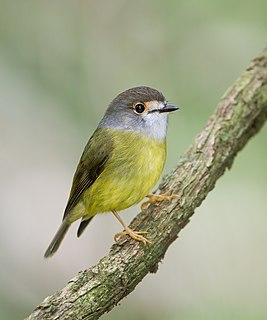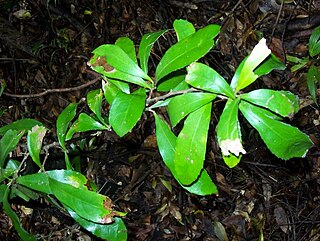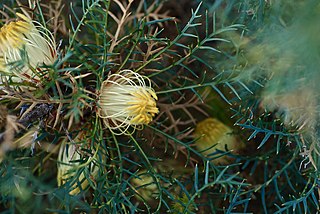External links
| This Tortricinae-related article is a stub. You can help Wikipedia by expanding it. |
| Asthenoptycha sphaltica | |
|---|---|
| Scientific classification | |
| Kingdom: | |
| Phylum: | |
| Class: | |
| Order: | |
| Family: | |
| Genus: | |
| Species: | A. sphaltica |
| Binomial name | |
| Asthenoptycha sphaltica Meyrick, 1910 | |
Asthenoptycha sphaltica is a species of moth of the family Tortricidae. It is found in Australia in the states of New South Wales and Victoria.
Adults have dark brown-and-white wings, with a pale mark on the inner margin of each forewing. The hindwings are a uniform pale grey.
| This Tortricinae-related article is a stub. You can help Wikipedia by expanding it. |

India pale ale (IPA) is a hoppy beer style within the broader category of pale ale.

Nankeen is a kind of pale yellowish cloth originally made in Nanjing, China from a yellow variety of cotton, but subsequently manufactured from ordinary cotton that is then dyed.

Banksia lanata is a species of shrub that is endemic to a restricted area of Western Australia. It has linear leaves, pale cream-coloured flowers in a head with whitish bracts at the base and later up to fifty elliptical follicles in each head.

Banksia oreophila, commonly known as the western mountain banksia or mountain banksia, is a species of shrub that is endemic to the south-west of Western Australia. It has glabrous stems, wedge-shaped or narrow egg-shaped leaves with the narrower end towards the base, cylindrical spikes of pale pink to mauve flowers and later, up to twenty follicles in each spike, surrounded by the remains of the flowers. It occurs on slopes and hilltops in the Stirling and Barren Ranges.
Banksia biterax is a species of dense shrub that is endemic to Western Australia. It has hairy stems, deeply serrated leaves and spikes of up to 200 pale to dark brown flowers.

Banksia columnaris is a species of column-like shrub that is endemic to Western Australia. It has pinnatifid leaves with between five and eighteen lobes on each side, heads of pale yellow to purple flowers and usually only one or two follicles forming in each head.

Banksia obovata, commonly known as wedge-leaved dryandra, is a species of shrub that is endemic to Western Australia. It has hairy stems, serrated, wedge-shaped to egg-shaped leaves with the lower end towards the base, cream-coloured or pale yellow flowers in heads of up to 100, and egg-shaped follicles. It is found in near-coastal areas in the south of the state.
Banksia echinata is a species of shrub that is endemic to Western Australia. It has serrated leaves with nine to twenty-five sharply pointed, triangular teeth on each side, heads of about fifty pale yellow flowers and sparsely hairy follicles.

Banksia nana, commonly known as dwarf dryandra, is a species of shrub that is endemic to a small area in the south-west of Western Australia. It has underground stems, pinnatipartite leaves with sharply-pointed lobes, pale green or yellow flowers and broadly egg-shaped follicles.
Banksia pallida is a species of column-shaped shrub that is endemic to the south-west of Western Australia. It has densely hairy stems, linear leaves with three to five serrations on each side, pale yellow flowers in heads of up to eighty and egg-shaped to elliptical follicles.

The pale-yellow robin is a species of passerine bird in the family Petroicidae. It is endemic to eastern Australia. Its natural habitat is subtropical or tropical moist lowland forests. It is a nondescript bird with grey head and olive upperparts, white throat and yellow underparts. The sexes are similar. Two subspecies are recognised: the smaller nana from North Queensland, and the larger and uncommon nominate race capito from southeast Queensland and northeastern New South Wales. It is insectivorous.

Grevillea alpivaga, also known as buffalo grevillea, is a species of the plant genus Grevillea. It is endemic to Victoria in Australia. The species grows as an erect to prostrate shrub, between 0.3 and 1 metre in height. Flowers usually appear between October and February in its native range. These have pale green, white or cream perianths and styles which are white to pale pink, becoming red.

Helicia glabriflora is a species of rainforest shrubs or small trees occurring in eastern Australia. Common names include smooth or pale helicia, pale, leather or brown oak. They grow naturally in a variety of different rainforest types from the Illawarra, New South Wales to the Townsville area, Queensland. Of all the global diversity of approximately one hundred Helicia species, this one species naturally grows the furthest south, in the Minnamurra Rainforest and the Robertson area, Illawarra, New South Wales, there observed more on the relatively fertile basalt and alluvial soils.

Hakea cycloptera, commonly known as elm-seed hakea, is a shrub in the family Proteaceae endemic to South Australia. It is a small spreading shrub with an abundance of pale pink or white flowers from December to August.

Adenanthos pungens, the spiky adenanthos, is a species of shrub in the family Proteaceae. It is endemic to the south-west of Western Australia.
Grevillea stenobotrya is a shrub in the family Proteaceae. It is endemic to arid regions of Australia. Common names include rattle-pod grevillea, sandhill grevillea and sandhill spider flower. Plants grow to between 1.5 and 6 metres in height and have leaves are linear and entire, or occasionally divided, and between 6 and 28 cm long and 0.7 to 2.5 mm wide. Flowers are cream, pale yellow or pale pink. These appear in clustered spikes at the end of branches between May and December in the species' native range. The fruits which follow are hard, flattened and rounded and have a short beak.

Lion is a beverage and food company that operates in Australia and New Zealand, and a subsidiary of Japanese beverage giant Kirin. It produces and markets a range of beer, wine, cider, RTDs and spirits, as well as dairy and other beverages. Lion was formed in October 2009 under the name "Lion Nathan National Foods" when Kirin Holdings Company Limited purchased brewer Lion Nathan and merged the business with National Foods, which it owned since 2007. In 2011, the company changed its name to Lion, with National Foods becoming a Melbourne-based subsidiary called Lion Dairy & Drinks. The company employs over 7000 people.
Hakea acuminata is a shrub of the family Proteaceae native to Western Australia. A restricted species bearing clusters of white flowers with a green or pinkish tinge in late autumn to winter.

Hakea hastata is a shrub in the family Proteaceae and is endemic to southern Western Australia. It is an open, upright shrub with light green leaves, branches covered in dense hairs and white flowers in spring.

Banksia recurvistylis is a species of shrub that is endemic to a restricted area of Western Australia. It has densely crowded, deeply serrated pinnate leaves, the lobes very narrow triangular, and heads of between twenty-five and forty pale yellow flowers.